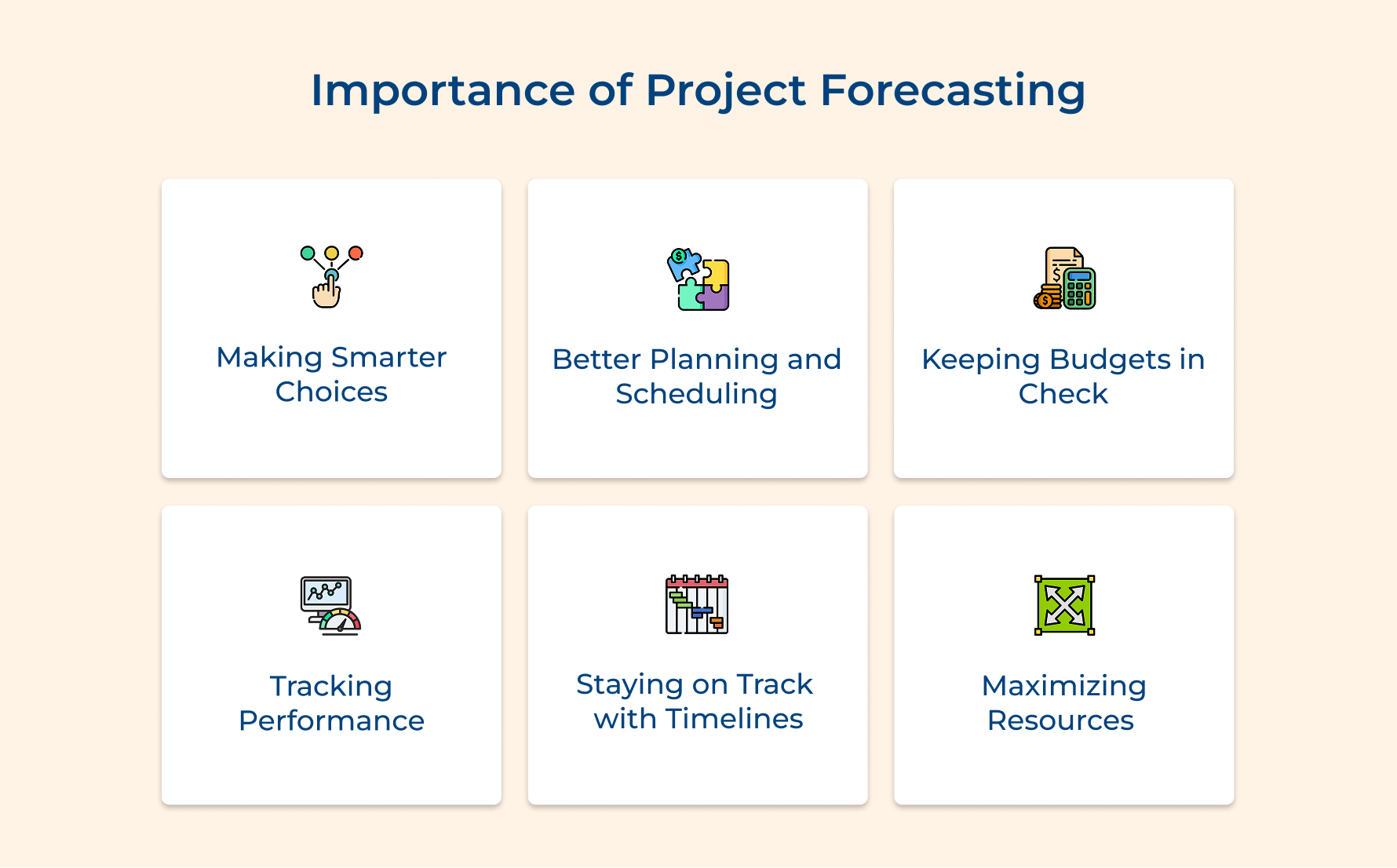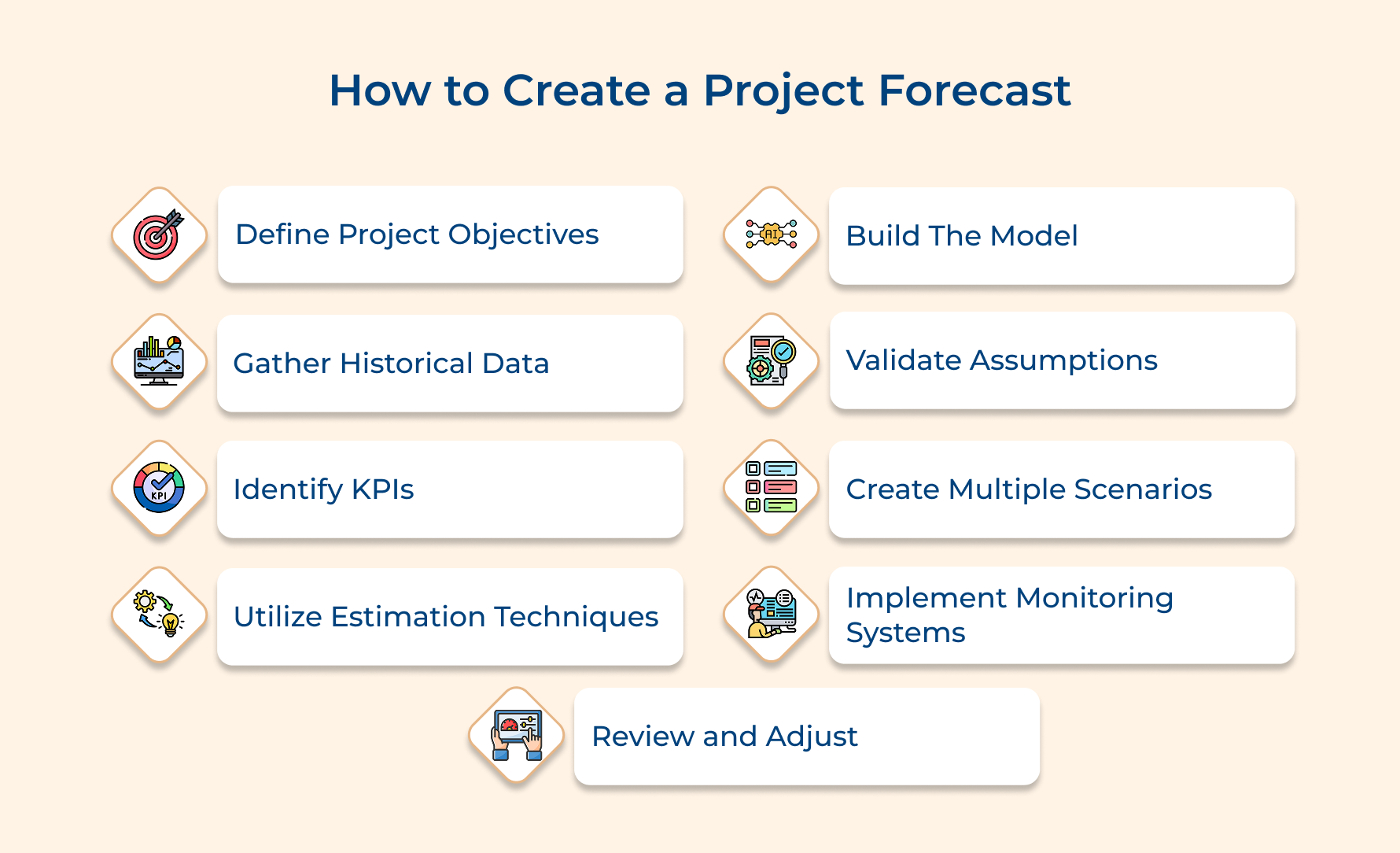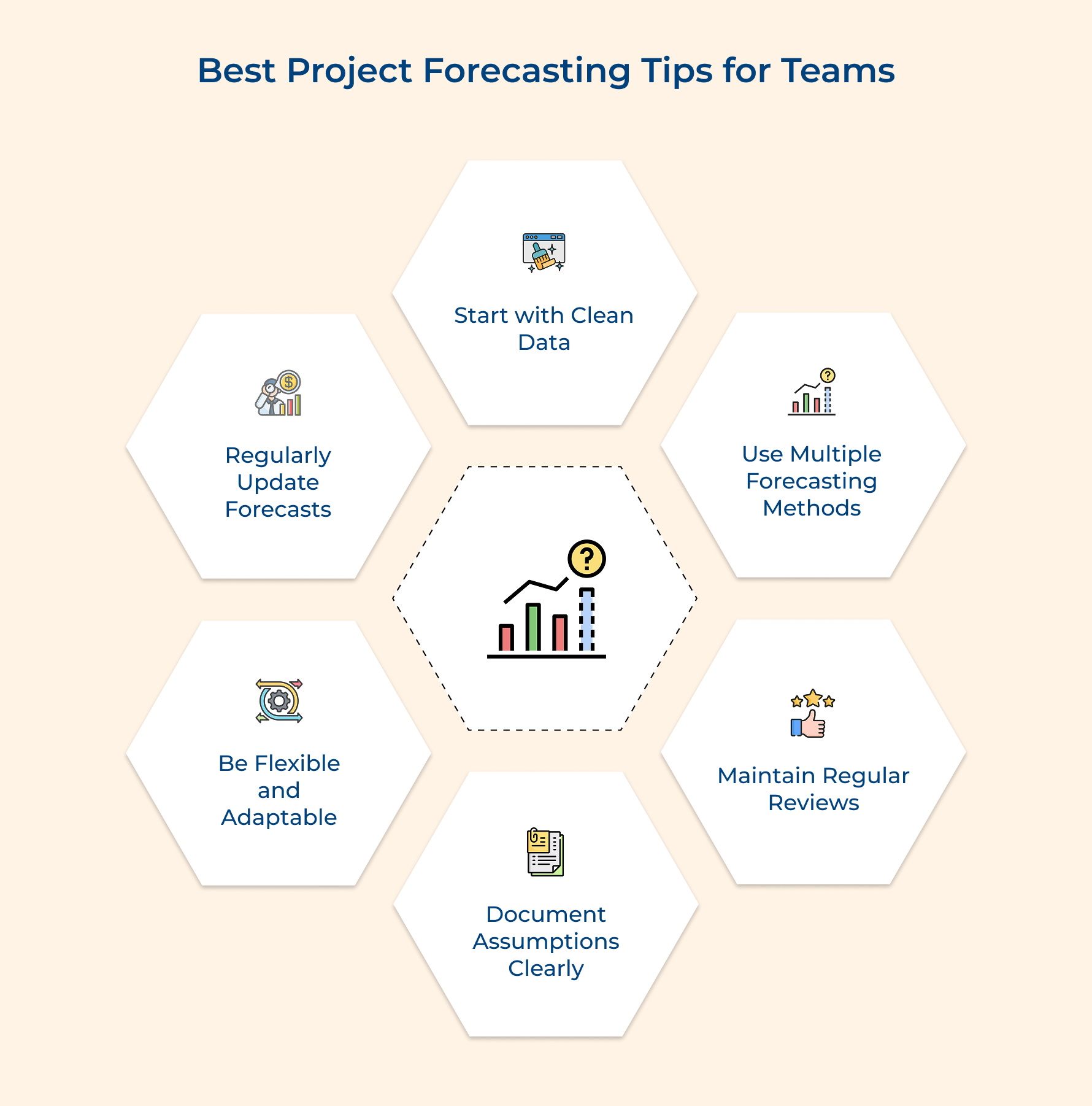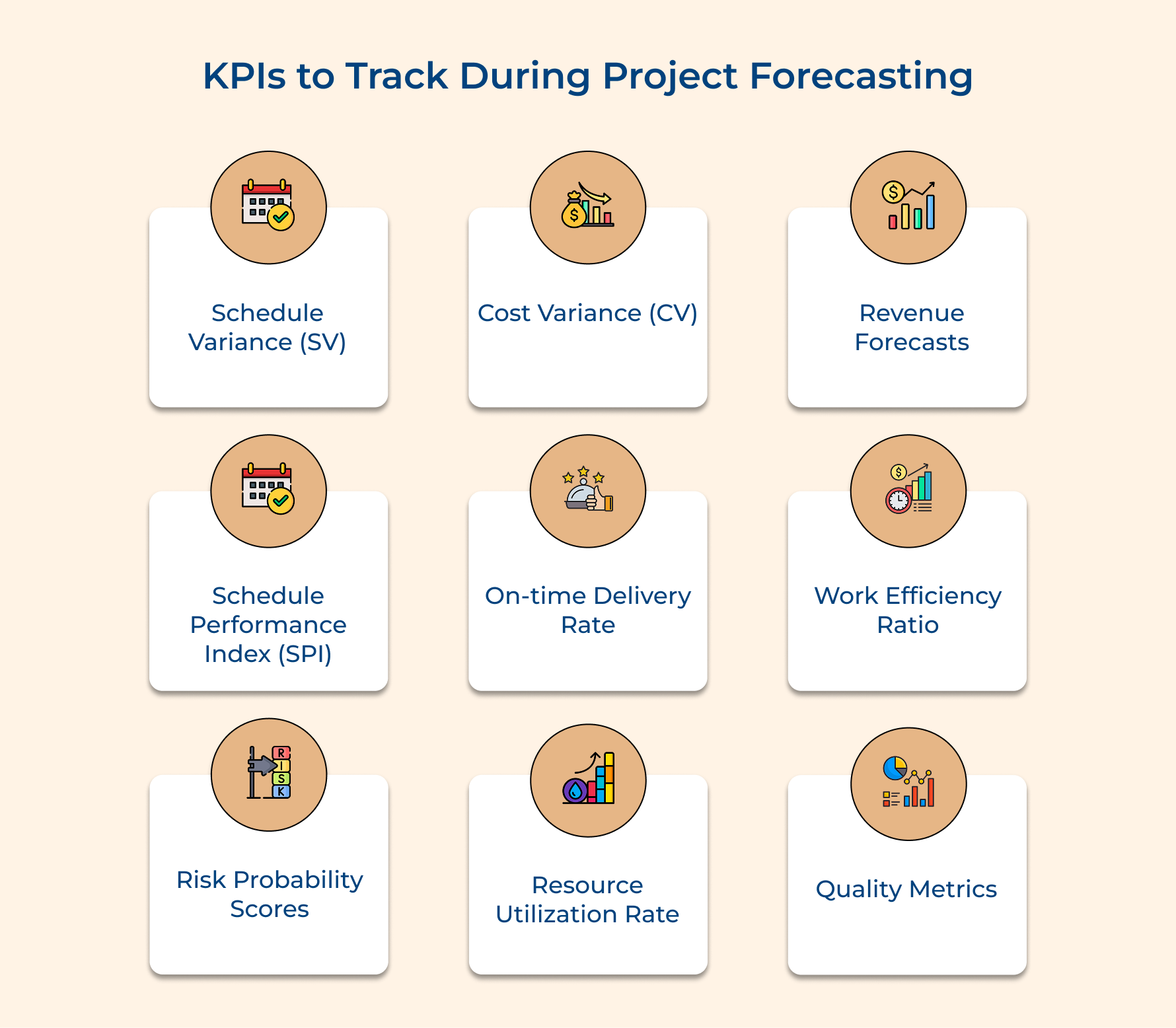Project Forecasting: Tips for Success & Key Strategies
- What is Project Forecasting?
- Importance of Project Forecasting in Project Management
- How do you Create a Project Forecast?
- Best Project Forecasting Tips for Teams
- Key Performance Metrics to Track During Project Forecasting
- A Comprehensive Look at the Necessity of Project Forecasting
- FAQs about Project forecasting

Key Highlights:
- Accurate project forecasting directly impacts project profitability and operational efficiency.
- Employing multiple forecasting methods enhances reliability and insights.
- Regular updates ensure forecasts stay relevant and adaptable to new challenges.
Did you know that nearly 70% of projects fail due to inadequate planning and forecasting?
The most common reasons would be inaccurate predictions where your teams end up risking overspending, missing deadlines, and jeopardizing their project’s success.
Project forecasting is an essential tool that empowers teams to anticipate challenges and allocate resources effectively. Accurate forecasts provide valuable insights that guide decision-making throughout the project lifecycle.
Let us delve into the fundamentals of project forecasting and share key strategies for enhancing forecasting accuracy as well as driving project success.
What is Project Forecasting?
Project forecasting is a strategic management process that predicts future project outcomes, requirements, and performance based on historical data, current metrics, as well as environmental factors.
It involves analyzing various project elements including timelines, resources, costs, and potential risks to create reliable predictions about project trajectory.
Accurate forecasting reduces uncertainty while increasing project success rates by identifying potential issues early, allowing teams to implement preventive measures rather than reactive solutions.
Key objectives:
- Resource allocation: Efficiently allocate resources based on predicted needs to ensure that the project remains on track without overburdening teams or causing delays.
- Budget management: Provide accurate cost estimates to prevent financial overruns and ensure that the project stays within budget constraints.
- Timeline planning: Establish realistic timelines to enhance scheduling accuracy, enabling better management of tasks and deadlines throughout the project lifecycle.
Importance of Project Forecasting in Project Management
Project forecasting is vital for successful project management, ensuring timely delivery and resource optimization. Here are the reasons why.
Making Smarter Choices
Forecasting gives project managers valuable insights to make informed decisions about resources, budgets, and schedules. By reducing uncertainty, teams have a better shot at meeting project goals.
Better Planning and Scheduling
With accurate forecasts, teams can create practical project plans and timelines. Predicting future needs and hurdles helps schedule tasks smartly, so deadlines are met without stretching resources too thin.
Keeping Budgets in Check
Forecasting helps estimate costs for every phase, making it easier to stick to the budget. Avoiding overspending ensures financial resources are used wisely throughout the project.
Tracking Performance
Regular forecasts set clear benchmarks for success. Teams can measure actual progress against predictions, which helps refine processes and improve future project planning.
Staying on Track with Timelines
Forecast models help teams maintain realistic schedules by spotting potential delays early. This allows for quick fixes and keeps the project moving efficiently.
Maximizing Resources
Accurate forecasting ensures resources are allocated efficiently. Teams can avoid overloading or underusing their capacity, keeping productivity high while preventing burnout.
How do you Create a Project Forecast?
To create a project forecast effectively, follow structured steps that ensure accurate predictions and informed decision-making. Here are the steps to follow.
1. Define Project Objectives and Scope
Setting clear project objectives is the key to accurate forecasting. It’s about defining deliverables, timelines, and what success looks like.
The given phase involves documenting project boundaries, resource needs, stakeholder expectations, and constraints, all while aligning with your organization’s goals.
Tips for Implementation
- Break down the project into a detailed work structure, covering all components and dependencies. Keep refining it to ensure no element is overlooked.
- Open clear communication channels with stakeholders to gather requirements effectively. Regular check-ins help avoid scope mismatches.
- Use standardized templates to document assumptions and constraints. Review them regularly to keep everything accurate and up to date.
2. Gather Historical Data
Looking at past projects gives valuable insights for predicting current ones. By analyzing previous performance metrics, challenges, and successes, you can spot trends, while also identifying risks, while also setting realistic benchmarks.
Where to Find Data?
- Project management systems: These hold metrics on timelines, costs, and resource use. Regularly pulling this data keeps things up-to-date.
- Team performance records: These reveal productivity trends and capabilities, helping forecast future performance.
- Industry benchmarks: Comparing your data with market standards ensures your forecasts align with current trends.
3. Identify Key Performance Indicators (KPIs)
KPIs are measurable goals to track project progress and success. Picking the right ones keeps you on top of things and supports proactive decision-making.
Key KPIs to Watch
- Schedule performance index: Tracks how closely you’re sticking to planned timelines. Regular checks catch delays early.
- Cost variance: Compares actual spending to your budget. Monthly reviews help manage finances effectively.
- Resource utilization rate: Measures team efficiency and capacity. Weekly tracking avoids burnout and overwork.
- Quality metrics: Assess deliverable standards and customer satisfaction. Frequent reviews ensure you’re meeting expectations.
4. Utilize Estimation Techniques
Reliable forecasts need robust estimation techniques. Your method will depend on the project type, data available, and accuracy needs.
Popular Techniques
- Bottom-up estimation: Breaks tasks into smaller parts for precision.
- Parametric modeling: Uses statistical links between variables, validated with historical data.
- Expert judgment: Taps into team experience, with regular checks for accuracy.
5. Build the Model
Creating a reliable forecast model means integrating key elements and keeping it flexible for updates. It ensures it stays accurate and useful throughout the project.
Core Components
- Timeline projections: Maps milestones and dependencies, updated regularly to reflect progress.
- Resource allocation plans: Details team assignments and workload. Weekly updates prevent conflicts.
- Cost estimates: Breaks down expected spending by category, reviewed monthly to stay on track.
6. Validate Assumptions
Testing assumptions is crucial for reliable forecasts. Regular reviews help catch issues early and make adjustments as needed.
How to Validate?
- Peer reviews: Bring in experts for thorough checks.
- Data verification: Confirm input accuracy with monthly audits.
- Sensitivity analysis: Test how variable changes affect outcomes.
7. Create Multiple Scenarios
Scenario planning prepares your team for different outcomes. By analyzing various possibilities, you can manage risks better.
Types of Scenarios
- Best case: Reflects optimal performance and conditions.
- Worst case: Prepares you for maximum risk impact.
- Most likely case: Strikes a balance between risks and opportunities.
8. Implement Monitoring Systems
Tracking actual performance against forecasts ensures you’re staying on course. Regular reviews help catch and address variances early.
What to Monitor?
- Performance tracking: Weekly updates to track progress.
- Variance analysis: Identifies gaps monthly for corrective action.
- Progress reporting: Keeps stakeholders in the loop with regular updates.
9. Review and Adjust
Frequent reviews and adjustments keep forecasts accurate as well as continuously improve them over time.
What to Focus On?
- Accuracy checks: Compare actuals to predictions for better insights.
- Trend analysis: Spot patterns to prevent issues early.
- Improvements: Use quarterly reviews to enhance processes continuously.
Best Project Forecasting Tips for Teams
Looking to master your project planning? These forecasting tips will help your team stay ahead, make smarter decisions, and achieve your goals with confidence!
Start with Clean Data
Accurate forecasting starts with reliable data. Clean, high-quality data helps you avoid mistakes that could lead to bad decisions, budget overruns, or missed deadlines.
Regularly auditing and validating your data keeps it trustworthy as well as sets a strong foundation for your forecasts.
On the flip side, inaccurate data can throw off your projections and erode trust with your team along with stakeholders.
Example: A construction company discovered that outdated resource data led to budget overruns, prompting the implementation of regular data checks. A monthly review of data sources ensured all information remained current and accurate.
Use Multiple Forecasting Methods
Employing a variety of forecasting methods enhances accuracy. Relying on a single method can limit perspective and fail to capture the complexity of project dynamics.
Combining qualitative insights with quantitative data provides a more comprehensive view, allowing for better-informed decisions.
For instance: A marketing team successfully combined customer surveys with historical campaign performance data, leading to more effective budget allocation. Analyzing trends from past campaigns alongside real-time consumer feedback enabled more accurate predictions for upcoming promotions.
Future trend: The integration of AI-driven analytics is becoming popular, allowing teams to uncover hidden patterns in data, thus enhancing the accuracy of various forecasting methods.
Maintain Regular Reviews
Regularly scheduled reviews are vital for ensuring forecasts remain relevant. Frequent assessments allow teams to adjust strategies based on real-time data and emerging trends, keeping projects on track as well as aligned with goals.
Strategies:
- Schedule weekly or bi-weekly review meetings focused on forecasting, ensuring participation from all team members.
- Use a shared agenda to keep discussions focused and productive, highlighting key performance indicators (KPIs) for assessment.
- Encourage open dialogue to address discrepancies promptly, creating a culture of transparency and collaboration.
Common Pitfalls:
- Failing to document the outcomes of reviews can lead to repeated mistakes. Always record decisions and action items from each review.
- Avoiding difficult conversations about discrepancies can erode trust. Encourage a culture of honesty and openness.
Document Assumptions Clearly
Clear documentation of assumptions behind forecasts is essential for transparency and accountability. This practice helps teams understand the basis of forecasts and facilitates easier revisions when conditions change.
Let’s say: A product team recorded assumptions about market growth, revisiting them to adjust their strategy as new data emerged. Regularly checking these assumptions against market realities ensured their forecasts remained relevant.
Tips:
- Create a dedicated section in project documentation for assumptions, making it easily accessible to all team members.
- Regularly revisit and revise assumptions during project reviews, encouraging team members to challenge outdated beliefs.
- Facilitate discussions around assumptions to identify potential issues early, allowing for quicker course corrections.
Be Flexible and Adaptable
Flexibility is key to effective forecasting. Adapting to new information and changing circumstances enables teams to align strategies with current market conditions as well as project needs. An agile approach builds resilience in the face of uncertainty.
Strategies:
- Hold regular strategy sessions to reassess goals and approaches, encouraging innovation along with adaptability.
- Build an agile mindset within the team to embrace change, providing training on agile methodologies if necessary.
- Implement processes that allow for quick adjustments to forecasts, ensuring preparedness for new challenges.
Future Trend: Agile forecasting practices are being adopted widely, where teams use iterative cycles to continuously refine their forecasts based on ongoing project developments.
Regularly Update Forecasts
Treat forecasting as a dynamic process. Regular updates based on new data ensure that forecasts remain relevant and accurate, helping teams make informed decisions throughout the project lifecycle.
Example: A nonprofit organization updated funding forecasts quarterly, adjusting outreach strategies in response to changing donor behaviors. This proactive approach maximized funding opportunities.
Strategies:
- Establish a protocol for updating forecasts after significant changes, ensuring that everyone is aware of adjustments.
- Use project management tools for real-time updates and tracking, streamlining the forecasting process.
- Share updates through communication platforms to keep the team aligned and informed, building a collaborative environment.
Key Performance Metrics to Track During Project Forecasting
Monitoring key performance metrics provides valuable insights into project health and progress. Here are the essential metrics to track.
- Schedule Variance (SV)
Measures the difference between planned completion dates and actual progress timelines. Regular monitoring helps identify delays early while enabling proactive adjustments. SV calculations provide critical insights for timeline management and resource allocation decisions, allowing project managers to maintain delivery schedules effectively.
- Cost Variance (CV)
Tracks differences between budgeted costs and actual expenditures throughout the project lifecycle. Monitoring cost variances enables financial control while highlighting potential budget overruns. Early detection allows the implementation of corrective measures before financial impacts become significant for project success.
- Revenue Forecasts
Projects the expected financial returns through detailed analysis of market conditions and project deliverables. Revenue tracking helps align project outcomes with business objectives while ensuring profitability. Regular forecast updates enable strategic decisions about resource investments and scope adjustments.
- Schedule Performance Index (SPI)
Compares work completed against planned progress through quantitative measurements. SPI calculations provide early warnings about project delays while guiding recovery planning. Regular monitoring enables teams to maintain momentum and adjust resources for optimal performance.
- On-time Delivery Rate
Measures the percentage of deliverables completed within scheduled timeframes. Tracking delivery rates identifies bottlenecks while maintaining stakeholder confidence. Regular monitoring helps optimize workflows and improve future planning accuracy through historical performance data.
- Work Efficiency Ratio
Analyzes productivity levels by comparing actual work hours against planned estimates. Efficiency tracking helps optimize resource allocation while identifying training needs. Regular monitoring enables continuous improvement in estimation accuracy and team performance.
- Risk Probability Scores
Evaluates the likelihood and potential impact of identified project risks. Regular risk assessment enables proactive mitigation strategies while preventing costly surprises. Score tracking helps prioritize risk management efforts and resource allocation decisions.
- Resource Utilization Rate
Monitors effective use of available resources against planned capacity. Utilization tracking prevents overallocation while maximizing productivity. Regular analysis helps optimize team assignments and identify capacity constraints before they impact delivery.
- Quality Metrics
Tracks defect rates, customer satisfaction, and compliance with project standards. Quality monitoring ensures deliverable excellence while maintaining stakeholder satisfaction. Regular measurement enables continuous improvement and helps establish quality benchmarks for future projects.
A Comprehensive Look at the Necessity of Project Forecasting
Project forecasting is crucial for enhancing profitability and efficiency. It helps teams identify potential risks, and allocate resources wisely while ensuring projects are completed on time as well as within budget. Accurate forecasts drive informed decision-making and strategic planning.
Effective forecasting involves utilizing clean data, implementing diverse methodologies, and regularly updating projections based on real-time insights. Such a continuous process allows teams to remain agile and responsive to changing project conditions.
Limit time — not creativity
Everything you need for customer support, marketing & sales.
Neeti Singh is a passionate content writer at Kooper, where he transforms complex concepts into clear, engaging and actionable content. With a keen eye for detail and a love for technology, Tushar Joshi crafts blog posts, guides and articles that help readers navigate the fast-evolving world of software solutions.



